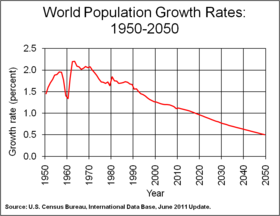Estimates


Sustainable population
Many studies have tried to estimate the world's sustainable population for humans, that is, the maximum population the world can host.[5] A 2004 meta-analysis of 69 such studies from 1694 until 2001 found the average predicted maximum number of people the Earth would ever have was 7.7 billion people, with lower and upper meta-bounds at 0.65 and 9.8 billion people, respectively. They conclude: "recent predictions of stabilized world population levels for 2050 exceed several of our meta-estimates of a world population limit".[6] A 2012 United Nations report summarized 65 different estimates of maximum sustainable population size and the most common estimate was 8 billion.[7][8]
Climate change, excess nutrient loading (particularly nitrogen and phosphorus), increased ocean acidity, rapid biodiversity loss, and other global trends suggest humanity is causing global ecological degradation and threatening ecosystem services that human societies depend on.[9][10][11] Because these environmental impacts are all directly related to human numbers, recent estimates of a sustainable human population tend to put forward much lower numbers, between 2 and 4 billion.[12][13][14] Paul R. Ehrlich stated in 2018 that the optimum population is between 1.5 and 2 billion.[15] Geographer Chris Tucker estimates that 3 billion is a sustainable number, provided human societies rapidly deploy less harmful technologies and best management practices.[16] Other estimates of a sustainable global population also come in at considerably less than the current population of 8 billion.[17][18][19]
A 2014 study published in the Proceedings of the National Academy of Sciences of the United States of America posits that, given the "inexorable demographic momentum of the global human population," efforts to slow population growth in the short term will have little impact on sustainability, which can be more rapidly achieved with a focus on technological and social innovations, along with reducing consumption rates, while treating population planning as a long term goal. The study says that with a fertility-reduction model of one-child per female by 2100, it would take at least 140 years to reduce the population to 2 billion people by 2153.[20][21] The 2022 "Scientists' warning on population," published by Science of the Total Environment, states that "environmental analysts regard a sustainable human population as one enjoying a modest, equitable middle-class standard of living on a planet retaining its biodiversity and with climate-related adversities minimized," which is estimated at between 2 and 4 billion people.[22]
Skeptics criticize the basic assumptions associated with these overpopulation estimates. For example, Jade Sasser believes that calculating a maximum of number of humanity which may be allowed to live while only some, mostly privileged European former colonial powers, are mostly responsible for unsustainably using up the Earth, is wrong.[23]
But if current human numbers are not ecologically sustainable, the costs are likely to fall on the world’s poorest citizens, regardless of whether they helped cause the problem.[24][25] In fact, countries that contribute the most to unsustainable production and consumption practices often have higher income per capita and slower population growth, unlike countries that have a low income per capita and rapidly growing populations.[26]
According to a 2022 study published in Sustainable Development, a sustainable population is required for both preserving biodiversity and food security. The study says that falling fertility rates are linked to access to contraception and family planning services, and has little to no relation to economic growth.[27]
World population
According to data from 2015, the world population is projected to reach 8.5 billion by 2030, up from the current 8 billion, to exceed 9 billion people by 2050, and to reach 11.2 billion by the year 2100.[28] Most of the increase will be in developing countries whose population is projected to rise from 5.6 billion in 2009 to 7.9 billion in 2050. This increase will be distributed among the population aged 15–59 (1.2 billion) and 60 or over (1.1 billion) because the number of children under age 15 in developing countries is predicted to decrease. In contrast, the population of the more developed regions is expected to undergo only slight increase from 1.23 billion to 1.28 billion, and this would have declined to 1.15 billion but for a projected net migration from developing to developed countries, which is expected to average 2.4 million persons annually from 2009 to 2050.[29] Long-term estimates in 2004 of global population suggest a peak at around 2070 of nine to ten billion people, and then a slow decrease to 8.4 billion by 2100.[30]
However, these projections assume substantial improvements in contraceptive availability throughout the developing world and large decreases in desired family size (particularly in sub-Saharan Africa), which may or may not happen.[31] In the end, all population projections must be taken with a large pinch of salt.[32] Particular care is needed to remember that future population size will depend on policy decisions and individual choices.[33]
